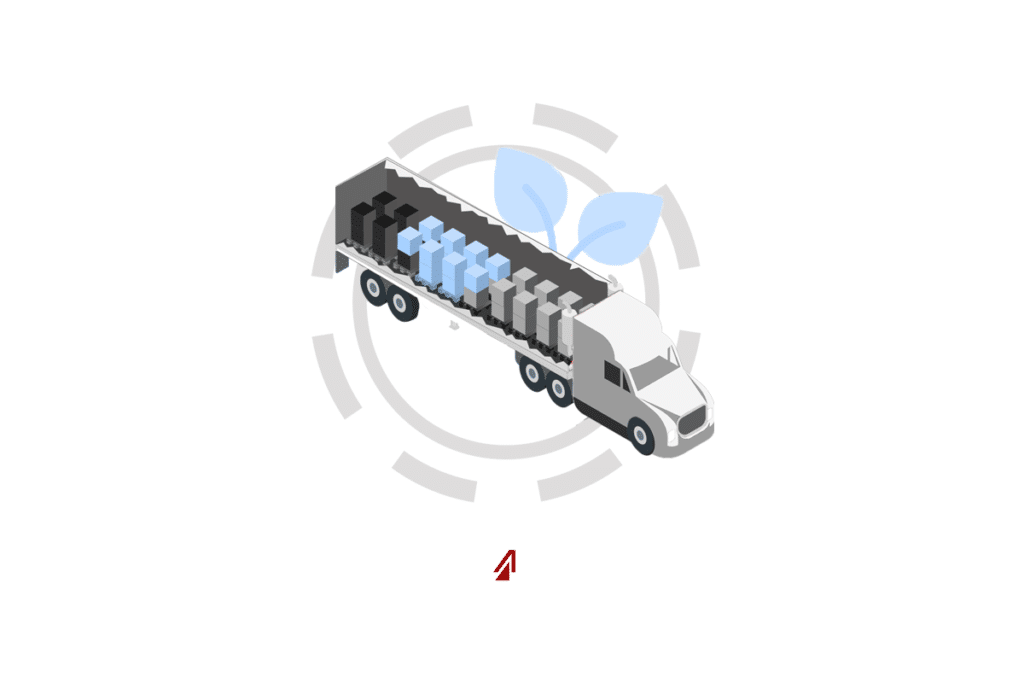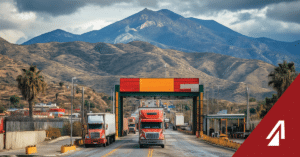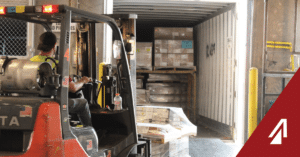Businesses today are looking for ways to be more sustainable – particularly in their supply chains. Transportation has shown consistently to be one of the highest areas of pollution and particulate emissions in the United States. Many companies are taking actions with their trucks. Some, are looking to natural gas solutions (See Cutting Carbs) or smaller vehicle loads; some of the most promising options at the forefront of sustainable technology are electric trucks. These vehicles promise all of the power and reliability of their diesel counterparts without the harmful emissions. Here are some of the top electric semi concepts being tested today.
BMW Group Trucks | Daimler | Nikola Motor | Freightliner | Tesla |
E-Force | MAN | Walmart | Thor | Cummins
BMW Group Trucks
Photo Credit http://www.e-hikelink.org/tr/content/bmw-and-scherm-group-launch-40-ton-electric-truck-pilot-project
Since 2015, BMW has produced three electric trucks within their group – each one currently operational and working around BMW’s home plant in Munich. First, the ARS Altmann AG – this vehicle features a fully covered semitrailer and transports fully built cars on a 15 kilometer route through and around Munich.
The second and third are built by the SCHERM Group, a partner of BMW. Their first vehicle covers several local routes a day and tops out at a maximum speed of 40 kilometers per hour. Annually, this vehicle saves nearly 48 tons of CO2 compared to traditional diesel trucks. The other model is slightly more robust and can drive at a top speed of 64 kilometers per hour with a range of 160 kilometers.
All three of BMW’s options are totally electric vehicles, and together they save nearly 82 tons of CO2 annually. “The topic of reducing CO2 emissions is more relevant than ever. We are therefore delighted that the BMW Group, together with its logistics service providers, is expanding its fleet of e-trucks and making a forward-looking contribution to reducing emissions in the city of Munich, “said Kapp.”We need innovative and sustainable logistics concepts in order to protect our citizens’ health and enable future production within the city at the same time.”
Daimler
Photo Credit https://www.daimler.com/innovation/case/electric/efuso-2.html
In 2017, the Mitsubishi Fuso Truck and Bus Corporation (MFTBC), a Daimler company, introduced the E-Fuso Vision One. This truck is an all-electric, zero-emission vehicle meant for heavy duty, inner city distribution trips. It has a gross vehicle weight of 23 tons and can handle an 11 ton payload. While not fully capable of long haul service, the E-Fuso Vision One is fit with up to 300 kWh batteries and can achieve 350 kilometers in a charge. Currently, Daimler is looking to release this vehicle in Europe, Japan, and the United States.
Nikola Motor
Photo Credit https://nikolamotor.com/one
Nikola, another zero-emission startup, is changing the long-range logistics market with their new Nikola One hybrid Class-8. This vehicle combines the electric capabilities of many of these other vehicles with a hydrogen fuel cell, allowing it to travel further, faster. The Nikola One is capable of achieving 500-1000 miles on a single charge supplemented by hydrogen. Some other benefits include:
• Energy efficient
• Aerodynamic shape
• Regenerative braking
• Lightweight
• Superior acceleration – nearly twice as fast as traditional diesel trucks
Of all of Nikola One’s features, some of the most impressive are the non-idling (ideal for states with idling laws like California) and the torque vectoring system. The Nikola One’s computers communicates with the motors around 30x per second and controls each wheel independently for speed. Each wheel can be singularly adjusted in real time for maximum efficiency.
Nikola is also making hydrogen fuel more realistic for other drivers as well. They are currently working on developing and installing close to 700 hydrogen fueling stations nationwide by 2028. They are starting with private stations in their home city of Phoenix, Arizona, and are gradually building more to suit their customers’ needs. Hydrogen, electrically generated – like Nikola’s, is a great sustainable option as there is no particulate exhaust and turns into water when electricity is generated.
Freightliner
Photo Credit https://freightliner.com/e-mobility/
Freightliner is a long-time Class-8 vehicle manufacturer, and they have brought their proven expertise to the electronic vehicle arena. The eCascadia combines the experience of Freightliner and Daimler to create a sustainable, electric vehicle with all of the power and capacity of traditional diesel vehicle with no emissions. It boasts a 730 horsepower engine and can range 250 miles on a single charge. Another significant feature is the 550 kWh battery that can recharge 80 percent in 90 minutes. Besides a proven track record, Freightliner offers:
• Real-world testing applications
• Leading edge efforts for creating CMV charging infrastructure as well as industry standards
• Support from factory trained technicians, parts, and customer support
Production is planned to launch in 2021.
Tesla
Photo Credit https://www.tesla.com/semi
Tesla has one of the biggest names in technologically advanced automobiles, and the new Tesla Semi is no exception to their lineup. It is touted as “the safest, most comfortable truck ever,” by Tesla’s website while still having the strength and speed to achieve 0-60 miles per hour with 80,000 pounds in 20 seconds or less. The Semi is equipped with four independent motors for maximum power and acceleration and can drive a five percent grade at 60 miles per hour – compared to the traditional diesel trucks’ 45 miles per hour.
According to Elon Musk, CEO of Tesla, the Semi was designed to mimic a bullet rather than a “brick wall”. It has a minimal drag coefficient of .36 – nearly half that of a standard diesel truck. It is even less than a Bugatti Chiron supercar (at .38). Tesla contends that since a driver is paid by the mile, that the drivers should be able to move as quickly and efficiently as possible to maximize their earning potential.
Its battery is not only sustainable, but also allows for greater range and more substantial savings than many of its competitors. This vehicle has two current models – one capable of 300 mile range and the other capable of 500 miles. They estimate both of these trucks will be able to save customers over $200,000 in fuel costs and pay for themselves in two years.
Some additional sustainable and technology-focused features include:
• Autopilot features for avoiding collisions and efficiency
• Center driver position in the cockpit to allow maximum visibility and control
• 2 large, state-of-the-art screens for data management, tracking, and visibility
• Low center of gravity
• Modifiable trailer flaps to increase aerodynamics
The Semi is full of included options and features that are ergonomically designed for driver comfort and sustainability.
E-Force
Photo Credit https://www.eforce.ch/en/
Founded in 2012, E-Force was one of the earliest pioneers of battery powered, sustainable trucks. They first developed the E-Force 18, an 18 ton electric truck, in 2013 and have continued development today. Recently, they have developed 4 electric models: EF18, EF15 SZM, EF26, and EF26 KSF. The ’18 models are their 18 ton trucks and the ’26 are 26 tons. Each truck can be customized to a customer’s specific needs with modular batteries and various trailer capabilities. Each model has a 350 kilometer range on a single charge, 440/550 kW output, and can achieve 85 kilometers per hour maximum speed.
E-Force offers innovative, electric technology, a powerful drivetrain, and a highly customizable platform. Each model has been thoroughly tested and ready to take on the open road.
MAN
Photo Credit https://www.truck.man.eu/de/en/man-etruck.html
“MAN has been taking its ecological responsibilities seriously for a long time and follows a clear roadmap when it comes to electromobility.” MAN has been developing concepts and production models of electronic trucks since 2009, but in 2016, they released the MAN eTruck. Currently, these electronic trucks are made in 18 and 26 ton models.
These vehicles are emission free, both CO2 and NOX, are extremely quiet, and have the same payload as other trucks in their class. At this time, they inner city applications with maximum range up to 200 kilometers with the maximum battery potential.
Walmart
Photo Credit https://news.walmart.com/news-archive/2014/03/26/walmart-debuts-futuristic-truck
On March 26, 2014, Walmart introduced its Walmart Advanced Vehicle Experience (WAVE) to the Mid-America Trucking Show in Louisville, Kentucky. The WAVE is a tractor/trailer combination featuring:
• State-of-the-Art aerodynamic design
• Turbine-powered hybrid drivetrain
• Electric auxiliary components
• Superior control systems
“Walmart is continually looking for innovative ways to increase our efficiencies and reduce our fleet’s emissions,” said Tracy Rosser, senior vice president of transportation at Walmart. “The Walmart Advanced Vehicle Experience is a bold step in transportation technologies that, although not on the road in its current form, will serve as a learning platform for the future that will accelerate our progress toward our goals.”
Each individual system of the vehicle has been refined for peak performance. Working with Peterbilt, Walmart has been able to achieve superior aerodynamics, driver comfort, and power while remaining sustainable and carbon neutral. The vehicle is powered by both alternative fuels, like liquid natural gas or biofuels, and electricity- with the turbine powertrain remaining at optimum RPMs while the electric motor handles acceleration and deceleration. It can, however, run on electricity alone until the battery reaches a 50 percent threshold. The turbine will then automatically charge the battery.
One of the most impressive features of the WAVE is the carbon fiber trailer. It is manufactured by Great Dane Trailers, and is constructed of single piece carbon fiber panels for the roof and sidewalls. These save nearly 4000 pounds in weight while maintaining a 16,000 pound forklift rating. Another interesting feature is the convex shaped nose – allowing greater aerodynamics. Lastly, the trailers are finished off with aerodynamic wheel coverings, low-amperage LED lighting strips, and a Posi-lift suspension kit.
Thor
Photo Credit https://www.thortrucks.com/et-one/
Thor’s ET-One is a rugged, dependable Class-8 vehicle backed by electricity. It is capable of short to mid-range hauls of around 300 miles, and can handle up to 80,000 pound capacity. Its powertrain is capable of 300-700 horsepower with full torque from zero revolutions per minute. Other benefits include:
• Regenerative braking
• Onboard safety systems
• Zero emissions
• Tier 1 components for minimum repairs
Thor boasts 60 percent cheaper maintenance costs as well as 70 percent reduction in fuel costs. It offers strength and sustainability at an affordable price. This vehicle is not just a concept – it is in full production and can be ordered today.
Cummins
Last but not least, Cummins offers their own Class-7 electric truck – the AEOS. Ideally made for hauling lighter urban deliveries, the truck has a 22 ton capacity, is outfitted with a 140 kWh battery pack, and can run for approximately 100 miles. The battery currently has an hour-long charge but Cummins has a goal of perfecting the design to 20 minutes by 2020.
Longer range versions are also planned for 2020, but will require supplement from diesel engines to power onboard generators. Cummins has stated that they do not intend to mass produce the AEOS itself, but will instead produce the battery packs and powertrains for other electric truck options.
Sustainability is the name of the game in modern logistics. Each company is looking for ways to make their shipping greener and more efficient. Each of these trucks are strong contenders to replace modern diesel vehicles and help make the world a cleaner, more productive place.













